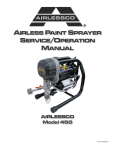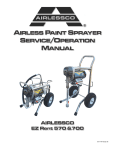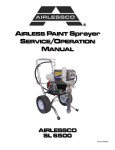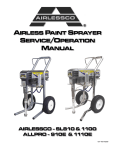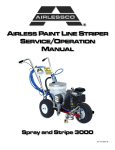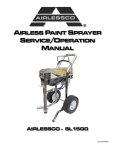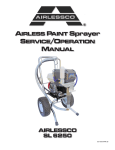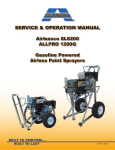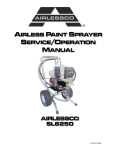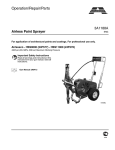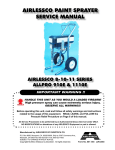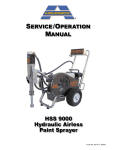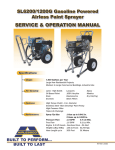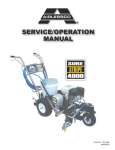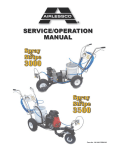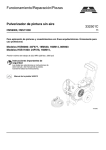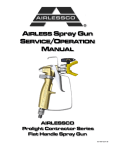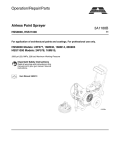Download AIRLESSCO HSS9000 Instruction manual
Transcript
AIRLESS PAINT SPRAYER SERVICE/OPERATION MANUAL AIRLESSCO HSS 9000 / HSS 11000 001-771 DEC 08 TABLE OF CONTENTS SECTION Introduction........................................................................ 1 Warnings ........................................................................... 2 Setting Up.......................................................................... 5 Flushing ............................................................................. 5 How to Flush...................................................................... 6 Starting Up ........................................................................ 7 Pressure Relief Procedure ................................................ 9 Airless Spray Gun Operation ...........................................10 Airless Spray Gun Troubleshooting..................................11 Line Striping Tip Chart .....................................................12 Field Troubleshooting .......................................................13 Servicing the Fluid Pump .................................................14 Servicing the Outlet Valve Assembly ...............................15 Servicing the Inlet Valve Assembly ..................................15 Packing Replacement Procedures ...................................16 Fluid Pump Assembly.......................................................17 Manifold Filter...................................................................18 Prime Valve ......................................................................18 Hydraulic Pump and Reservoir.........................................19 Hydraulic Motor Assembly............................................... 20 Frame Assembly ..............................................................21 Direct Immersion Unit...................................................... 22 Siphon Unit...................................................................... 23 Power Unit ....................................................................... 24 Suction Assemblies ......................................................... 25 Airlessco Accessories ..................................................... 26 Airlessco 5397 N. Commerce Ave, Moorpark, CA 93021 www.airlessco.com • (805) 523-0211 2 FIGURE 1. Filling the Packing Nut/Wet Cup.................................. 5 2. Spray Gun Tip ............................................................. 6 3. Prime Valve ................................................................. 6 4. Engine Controls ........................................................... 6 5 Grounding Spray Gun ................................................. 6 6. Pressure Control ......................................................... 6 7. Gun Safety Latch ........................................................10 8. Gun Components .......................................................10 9. Spray Tip ....................................................................10 10. Spray Tip Assembly....................................................10 11. Fluid Pump..................................................................14 12. Outlet Valve ................................................................15 13. Inlet Valve ...................................................................15 14. Fluid Pump Assembly.................................................16 15. Manifold Filter .............................................................18 16. Prime Valve ................................................................18 17. Hydraulic Pump and Reservoir ...................................19 18. Hydraulic Motor ......................................................... 20 19. Frame Assembly.........................................................21 20. Direct Immersion Unit................................................ 22 21. Siphon Unit ................................................................ 23 22. Power Unit HSS9000 ................................................ 24 23. Power Unit HSS11000............................................... 24 24. Suction Assembly...................................................... 25 25. Suction Assembly...................................................... 25 26. Inlet Suction Assembly .............................................. 25 27. Inlet Suction Assembly .............................................. 25 INTRODUCTION The Airlessco HSS series is designed with the features painters have come to expect from the Speedflo ® PowerTwinTM Series, while raising the bar in in hydraulic and paint pump performance. We also substantially enhanced the overall durabillity. The HSS series is offered with a variety of available power options that let you take advantage of the greater performance and value potential inherent with the HSS series of pumps. A careful look at these machines will show we have designed in the very best quallity components available, including an American made Vickers hydraulic pump. This pump has been proven for years on heavy construction equipment used around the world. HSS9000 power modules mount on their own subframe for quick "No Tools" installation and removal for transportaion and storage. Just pivot the fan belt cover out of the way, slip off the drive belt, and lift off the power unit. HSS9000 HSS11000 Max Pressure 3300 PSI 3300 PSI Output (FreeFlow) 2.70 GPM 3.30 GPM Output (At Pressure) 2.40 GPM 3.00 GPM Tip Size (1 Gun) 0.052 in. 0.057 in. Tip Size (2 Guns) 0.038 in. 0.041 in. Tip Size (3 Guns) 0.027 in. 0.031 in. Motor Honda GX200 Durotech 6.5HP Honda GX270 Durotech 9.0HP 140 lbs 232 lbs Weight (w/o motor) HANDLE THIS UNIT AS YOU WOULD A LOADED FIREARM! HIGH PRESSURE SPRAY CAN CAUSE EXTREMELY SERIOUS INJURY. OBSERVE ALL WARNINGS! MANUAL NOTATIONS WARNING - Alerts user to avoid or correct conditions that could cause bodily injury. CAUTION - Alerts user to avoid or correct conditions that could cause damage to or destruction of equipment. BEFORE OPERATING THIS UNIT, READ AND FOLLOW ALL SAFETY WARNINGS AND INSTRUCTIONS RELATED TO THE USAGE OF THIS EQUIPMENT ON PAGES 2, 3 & 4. READ, LEARN, AND FOLLOW THE PRESSURE RELIEF PROCEDURE ON PAGE 9 OF THIS MANUAL. IMPORTANT - Alerts users to steps or procedures that are essential to proper equipment repair and maintenance. NOTE - Identifies essential procedures or extra information. All Service Procedures to be performed by an Authorized Airlessco Service Center ONLY. NO MODIFICATIONS or alterations of any AIRLESSCO Equipment or part is allowed. 1 WARNINGS MEDICAL ALERT - Airless Spray Wounds If any fluid appears to penetrate your skin, get EMERGENCY MEDICAL CARE AT ONCE. DO NOT TREAT AS A SIMPLE CUT. Tell the doctor exactly what fluid was injected. Have him read the following "NOTE TO PHYSICIAN". NOTE TO PHYSICIAN: Injection in the skin is a traumatic injury. It is important to treat the injury surgically as soon as possible. DO NOT DELAY treatment to research toxicity. Toxicity is a concern with some exotic coatings injected directly into the blood stream. Consultation with a plastic surgeon or reconstructive hand surgeon may be advisable. HIGH PRESSURE SPRAY CAN CAUSE EXTREMELY SERIOUS INJURY. OBSERVE ALL WARNINGS. THIS SPRAYER IS FOR PROFESSIONAL USE ONLY. INJECTION HAZARD FLUIDS UNDER HIGH PRESSURE FROM SPRAY OR LEAKS CAN PENETRATE THE SKIN AND CAUSE EXTREMELY SERIOUS INJURY, INCLUDING THE NEED FOR AMPUTATION. NEVER point the spray gun towards anyone or at any part of the body. NEVER put hand or fingers over the spray tip. Do not use rag or other materials over your fingers. Paint will penetrate through material and into the hand. NEVER try to stop or deflect leaks with your hand or body. ALWAYS have gun tip guard in place when spraying. ALWAYS lock gun trigger when you stop spraying. ALWAYS remove tip from the gun to clean it. NEVER try to "blow back" paint, it’s not an air sprayer. ALWAYS follow the PRESSURE RELIEF PROCEDURE, as shown on page 9, before cleaning or removing the spray tip or servicing any system equipment. Be sure equipment safety devices are operating properly before each use. ALWAYS tighten all fluid connections before each use. MEDICAL TREATMENT If any fluid appears to penetrate your skin, get EMERGENCY CARE AT ONCE. DO NOT TREAT AS A SIMPLE CUT. • Go to an emergency room immediately. • Tell the doctor you suspect an injection injury. • Tell him what kind of material you were spraying with and have him read NOTE TO PHYSICIAN above. GENERAL PRECAUTION 2 NEVER alter equipment in any manner. NEVER smoke while in spraying area. NEVER spray highly flammable materials. NEVER use around children. NEVER allow another person to use sprayer unless he is thoroughly instructed on its' safe use and given this operators manual to read. ALWAYS wear a spray mask, gloves and protective eye wear while spraying. ALWAYS ensure fire extinquishing equipment is readily available and properly maintained. NEVER LEAVE SPRAYER UNATTENDED WITH PRESSURE IN THE SYSTEM. FOLLOW PRESSURE RELIEF PROCEDURES ON PAGE 9. ALWAYS INSPECT SPRAYING AREA Keep spraying area free from obstructions. Make sure area has good ventilation to safely remove vapors. NEVER keep flammable material in spraying area. NEVER spray in vicinity of open flame or other sources of ignition. Spraying area must be at least 20 ft. away from spray unit. SPRAY GUN SAFETY ALWAYS set safety lock on the gun in "LOCKED" position when not in use and before servicing or cleaning. DO NOT remove or modify any part of gun. ALWAYS remove spray tip when cleaning. Flush unit with LOWEST POSSIBLE PRESSURE. CHECK operation of all gun safety devices before each use. Be very careful when removing the spray tip or hose from gun. A plugged line contains fluid under pressure. If the tip or line is plugged, follow the PRESSURE RELIEF PROCEDURE as outlined on page 9.TIP GUARD TIP GUARD ALWAYS have the tip guard in place on the spray gun while spraying. The tip guard alerts you to the injection hazard and helps prevent accidentally placing your fingers or any part of your body close to the spray tip. SPRAY TIP SAFETY USE EXTREME CAUTION when cleaning or changing spray tips. If the spray tip clogs while spraying, engage the gun safety latch immediately. ALWAYS follow the PRESSURE RELIEF PROCEDURE before removing the spray tip to clean it. NEVER wipe off build up around the spray tip. ALWAYS remove tip & tip guard to clean AFTER pump is turned off and the pressure is relieved by following the PRESSURE RELIEF PROCEDURE. LABELING Keep all labels on the unit clean and readable. Replacement labels are available from manufacturer. WARNINGS CONTINUED ON NEXT PAGE......... WARNINGS - CONTINUED HOSES Tighten all fluid connections securely before each use. High pressure fluid can dislodge a loose coupling or allow high pressure spray to be emitted from the coupling and result in an injection injury or serious bodily injury. Only use a hose that has a spring guard. The spring guard helps protect the hose from kinks or other damage which could result in hose rupture and cause an injection injury. NEVER use a damaged hose, which can result in hose failure or rupture and cause in injection injury or other serious bodily injury or bodily damage. Before each use, check entire hose for cuts, leaks, abrasion or bulging of cover, or damage or movement of couplings. If any of these conditions exist, replace the hose immediately. NEVER use tape or any device to try to mend the hose as it cannot contain the high pressure fluid. NEVER ATTEMPT TO RECOUPLE THE HOSE. High pressure hose is not recoupleable. Help prevent damage to the hose by handling and routing it carefully. Do not move the sprayer by pulling it with the hose. TOXIC FLUID HAZARD Hazardous fluid or toxic fumes can cause serious injury or death if splashed in eyes or on skin, inhaled or swallowed. Know the hazards of the fluid you are using. Store & dispose of hazardous fluids according to manufacturer, local, state & national guidelines. ALWAYS wear protective eyewear, gloves, clothing and respirator as recommended by fluid manufacturer. KEEP CLEAR OF MOVING PARTS Keep clear of moving parts when starting or operating the sprayer. Do not put your fingers into any openings to avoid amputation by moving parts or burns on hot parts.Precaution is the best insurance against an accident. When starting the engine, maintain a safe distance from moving parts of the equipment. GROUNDING Ground the sprayer and other components in the system to reduce the risk of static sparking, fire or explosion which can result in serious bodily injury and property damage. ALWAYS GROUND ALL OF THESE COMPONENTS: 1. Sprayer: Connect a ground wire and clamp (supplied) to a true earth ground. 2. Fluid Hose: use only grounded hoses. 3. Spray gun or dispensing valve: grounding is obtained through connection to a properly grounded fluid hose and pump. 4. Object being sprayed: according to your local code. 5. All solvent pails used when flushing should only be metal pails which are conductive. Once each week, check electrical resistance of hose (when using multiple hose assemblies, check overall resistance of unpressurized hose must not exceed 29 megohms (max) for any coupled length or combination of hose lengths. If hose exceeds these limits, replace it immediately. Never exceed 500 Ft. (150 m.) overall combined hose length to assure electrical continuity. PREVENT STATIC SPARKED FIRE/ EXPLOSIONS ALWAYS be sure all equipment and objects being sprayed are properly grounded. ALWAYS ground sprayer, paint bucket and object being sprayed. See "grounding" above, for detailed grounding information. Vapors created when spraying can be ignited by sparks. To reduce the risk of fire, always locate the sprayer at least 20 feet (6 m.) away from the spray area. DO NOT plug in or unplug any electrical cords in the spray area, which can create sparks, when there is any chance of igniting vapors still in the air. Follow the coating & solvent manufacturers safety warnings and precautions. Use only conductive fluid hoses for airless applications. Be sure gun is grounded through hose connections. Check ground continuity in hose & equipment. Overall (end to end) resistance of unpressurized hose must not exceed 29 megohms for any coupled length or combination of hose length. Use only high pressure airless hoses with static wire approved for 3300 psi. Before adjusting or servicing any mechanical part of the sprayer, follow the PRESSURE RELIEF PROCEDURE on page 9, and remove the ignition cable from the spark plug to prevent accidental starting of sprayer. WARNINGS CONTINUED ON NEXT PAGE......... 3 WARNINGS - CONTINUED AVOID COMPONENT RUPTURE This sprayer operates at 3300 psi (225 bar). ALWAYS be sure that all components and accessories have a maximum working pressure of at least 3000 psi to avoid rupture which can result in serious bodily injury including injection and property damage. NEVER leave a pressurized sprayer unattended to avoid accidental operation of it which could result in serious bodily injury. ALWAYS follow the PRESSURE RELIEF PROCEDURE whenever you stop spraying and before adjusting, removing or repairing any part of the sprayer. NEVER alter or modify any part of the equipment to avoid possible component rupture which could result in serious bodily injury and property damage. NEVER use weak or damaged or non-conductive paint hose. Do not allow kinking or crushing of hoses or allow it to vibrate against rough or sharp or hot surfaces. Before each use, check hoses for damage and wear and ensure all fluid connections are secure. REPLACE any damaged hose. NEVER use tape or any device to mend the hose. NEVER attempt to stop any leakage in the line or fittings with your hand or any part of the body. Turn off the unit and release pressure by following PRESSURE RELIEF PROCEDURE. ALWAYS use approved high pressure fittings and replacement parts. ALWAYS ensure fire extinquishing equipment is readily available and properly maintained. WARNING: Do not use halogenated solvents in this system. The prime valve, 2 gun manifold and most airless guns have aluminum parts and may explode. Cleaning agents, coatings, paints or adhesives may contain halogenated hydrocarbon solvents. DON"T TAKE CHANCES! Consult your material suppliers to be sure. Some of the most common of these solvents are: Carbontetrachloride, Chlorobenzene, Dichloroethane, Dichloroethyl Ether, Ethylbromide, Ethylchloride, Tethrachloethane. Alternate valves and guns are available if you need to use these solvents. 4 FLUSHING Reduce the risk of injection injury, static sparking or splashing by following the specific cleaning procedure on page 7 and 9. ALWAYS follow the PRESSURE RELIEF PROCEDURE on page 9. ALWAYS remove the spray tip before flushing. Hold a metal part of the gun firmly to the side of a metal pail and use the lowest possible fluid pressure during flushing. NEVER use cleaning solvents with flash points below 140 degress F. Some of these are: acetone, benzene, ether, gasoline, naphtha. Consult your supplier to be sure. NEVER SMOKE IN THE SPRAYING/CLEANING AREA. GAS ENGINE PRECAUTIONS Locate unit 25 feet away from spray area in well ventilated area. NEVER operate in closed building unless exhaust is piped outside. NEVER allow hose to lay against engine mufflers or hot parts. NEVER refill fuel tank while engine is hot or is running. IMPORTANT: United States Government safety standards have been adopted under the Occupational Safety & Health Act. These standards, particularly the General Standards, Part 1910, & the Construction Standards, part 1926 should be consulted. WHEN SPRAYING & CLEANING WITH FLAMMABLE PAINTS OR THINNERS: 1. When spraying with flammable liquids, the unit must be located a minimum of 25 feet away from the spraying area in a well ventilated area. Ventilation must be sufficient enough to prevent the accumulation of vapors. 2. To eliminate electrostatic discharge, ground the spray unit, paint bucket and spraying object. Use only high pressure airless hoses approved for 3300 psi which is conductive. 3. Remove spray tip before cleaning gun and hose. Make contact of gun with bucket and spray without the tip in a well ventilated area, into the grounded steel bucket. 4. Never use high pressure in the cleaning process. USE MINIMUM PRESSURE. 5. Do not smoke in spraying/cleaning area. SETTING UP 1. CONNECT THE HOSE AND GUN a. Remove the plastic cap plug from the outlet and screw a conductive or grounded 3000 psi spray hose onto fluid outlet. b. Connect an airless spray gun to the other end of the hose, but do not install the spray tip yet! NOTE: Do not use thread sealer on swivel unions as they are made to self seal. 2. FILL THE PACKING NUT/WET CUP FIG. 1 Fill the Packing Nut/Wet Cup with 5 drops of Airlessco Throat Seal Oil (TSO). 3. CHECK THE ENGINE OIL LEVEL a. Unscrew the oil fill plug. The dipstick is attached to the plug. b. Without threading the plug into place, check to be sure the oil is up to the top mark on the dipstick. c. If oil is needed, refer to engine manual. 4. FILL THE FUEL TANK WARNING WARNING: Fuel spilled on a hot surface can cause a fire or explosion and cause serious bodily injury and property damage. Always shut off the engine and let it cool before filling the tank, and carefully follow steps a - c below being sure not to spill any fuel. a. Close the fuel shutoff valve. b. Use only clean, fresh, well-known brands of unleaded regular grade gasoline. c. Remove the fuel cap and fill tank. Be sure the air vent in the fill cap is not plugged so fuel can flow to the carburetor, then replace the cap. FLUSHING 1. NEW SPRAYER Your unit was factory tested in an oil solution which was left in the pump. Before using oil-base paint, flush with mineral spirits only. Before using water-base paint flush with mineral spirits, followed by soapy water, then a clean water flush. 2. CHANGING COLORS Flush with a compatible solvent such as mineral spirits or water. 3. CHANGING FROM WATER-BASE TO OIL-BASE PAINT Flush with soapy water, then mineral spirits. 4. CHANGING FROM OIL-BASE TO WATER-BASE PAINT 5. STORAGE Oil-base paint: Flush with mineral spirits. Water-base paint: Flush with water, then mineral spirits and leave the pump, hose and gun filled with mineral spirits. For longer storage, use mixture of mineral spirits and motor oil (half & half). Shut off the sprayer, follow PRESSURE RELIEF PROCEDURE on page 9 to relieve pressure and make sure prime valve is left open. 6. START UP AFTER STORAGE Before using water-base paint, flush with soapy water and then a clean water flush. When using oil-base paint, flush out the mineral spirits with the material to be sprayed. Flush with mineral spirits, followed by soapy water, then a clean water flush. 5 HOW TO FLUSH FLUSHING PROCEDURE 1. Be sure the gun safety latch is engaged and there is no spray tip in the gun. Refer to Fig. 2. Refer to your separate instruction manual provided with your gun on its safety features and how to engage safety latch. 2. Pour enough clean, compatible solvent into a large, empty metal pail to fill the pump and hoses. 3. Place the suction tube into the pail or place the pail under the pump. 4. Turn the pressure control knob to low pressure. Refer to Fig. 3. 5. Open the prime valve to the open - "Priming Position". This will allow an easy start. Refer to Fig. 3. 6. Turn the engine ON/OFF switch to ON. 7. Move the choke toward the closed position as per Fig.4. 8. Move the throttle lever slightly to the left as per Fig.4. 9. Turn the fuel valve ON as per Fig. 4. Pull the start rope. Pull the engine over against compression stroke and then let the rope rewind slowly into the starter. Pull firmly and rapidly to start the engine. Do NOT drop the rope. Hold on to the handle while rewinding, or the rope may rewind improperly and jam the assembly. If the engine does not start, open the choke a little more. If the engine floods, open the choke all the way and continue cranking. 10. After the engine is warm, gradually close the choke lever, increase the RPM of engine slightly by moving throttle to the left. Close the prime valve. Refer to Fig. 3 11. Point the gun into the metal pail and hold a metal part of the gun firmly against the pail Refer to fig.5 12. Disengage the gun safety latch and squeeze the gun trigger. At the same time, slowly turn the pressure control knob (Fig. 3) clockwise just enough to move liquid at low pressure. 13. Allow the pump to operate until clean solvent comes from the gun. 14. Release the trigger and engage the gun safety latch. 15. If you are going to start spraying, place the pump or suction tube into the supply container. Release the gun safety latch and trigger the gun into another empty, metal container, holding a metal part of the gun firmly against the metal pail (Fig. 5), forcing the solvent from the pump and hose. When paint starts coming from gun, turn pressure control knob to minimum pressure, place prime valve in prime (open) position and engage the gun safety latch. 16. If you are going to store the sprayer, remove the suction tube or pump from the solvent pail force the solvent from the pump and hose. Engage the gun safety latch and refer to the "Storage" Procedure on page 5. Step 5. 17. Whenever you shut off the sprayer follow the PRESSURE RELIEF PROCEDURE warning on page 9. 6 FIG. 2 FIG. 3 PRIME VALVE CLOSED (Pressure) REMOVE SPRAY TIP. ENGAGE GUN SAFETY LATCH. OPEN (Priming & Pressure Relief FIG. 4 CHOKE LEVER FUEL VALVE WARNING: To reduce the risk of static sparking which can cause fire or explosion, always hold a metal part of the gun firmly against the metal pail when flushing. This also reduces splashing. Refer to figure 3 THROTTLE LEVER FIG. 5 MAINTAIN FIRM METAL TO METAL CONTACT BETWEEN GUN AND CONTAINER FIG. 6 HYDRAULIC PRESSURE CONTROL ASSEMBLY STARTING UP 1. LEARN THE CONTROLS PRESSURE CONTROL KNOB - used to adjust pressure only. Turn clockwise to increase pressure and counterclockwise to decrease pressure. (See Fig. 6) PRIME & PRESSURE RELIEF VALVE - Turn to OPEN position (see Fig. 3) to prime the pump. Turn to the CLOSED position to spray. FOLLOW "PRESSURE RELIEF PROCEDURES" ON PAGE 9 WHENEVER YOU: - are instructed to relieve pressure - stop spraying - checking or servicing any of the system equipment. - or installing or cleaning the spray tip. HANDLE SPRAY SYSTEM AS YOU WOULD A LOADED FIREARM! CAUTION: Do not start engine without fluid pump having enough fluid so that it can be primed. Running fluid pump dry will decrease life of the pumps packings. 2. PREPARE THE MATERIAL a. Prepare the material according to the material manufacturer's recommendations. b. Place pump or suction tube into material container. 3. STARTING THE SPRAYER SEE FIGURE 3 & 6 ON PREVIOUS PAGE a. Prime Valve must be open - priming position. b. Pressure Control Knob must be in low pressure. c. Follow the procedure under "How to Flush", page 6, steps 6 through 12. WARNING To stop the unit in an emergency or before performing any service or maintenance procedure follow the PRESSURE RELIEF PROCEDURE on page 9 to relieve the fluid pressure. WARNING If you spray into the paint bucket, always use the lowest spray pressure and maintain firm metal to metal contact between gun and container. See page 6, Fig 5. 5. ADJUSTING THE PRESSURE a. Turn the Pressure Control Knob Clockwise to increase pressure and counterclockwise to decrease pressure. b. Always use the lowest pressure necessary to completely atomize the material. NOTE: Operating the sprayer at higher pressure than needed, wastes material, causes early tip wear, and shortens sprayer life. c. If more coverage is needed, use a larger tip rather than increasing the pressure. d. Check the spray pattern. The tip size and angle determines the pattern width and flow rate. WARNING Follow the "PRESSURE RELIEF PROCEDURE". To reduce the risk of injection, never hold your hand, body, fingers or hand in a rag in front of the spray tip when cleaning or checking for a cleared tip. Always point the gun toward the ground or into a waste container when checking to see if the tip is cleared or when using a self-cleaning tip. WARNING When you spray into the paint bucket, always use the lowest spray pressure and maintain firm metal to metal contact between gun and container. WARNING To stop the unit in an emergency, turn the motor off. Then relieve the fluid pressure in the pump and hose as instructed in the PRESSURE RELIEF PROCEDURE. 4. PRIME THE PUMP a. Allow pump to operate until paint comes from gun. b. Release the trigger and engage the gun safety latch. c. Turn Prime Valve OPEN to the prime position ensuring the pressure is released from the system. d. Turn Pressure Control Knob to minimum pressure. e. Install spray tip onto gun. f. Close the prime valve to the pressure position. g. Turn the pressure control knob to desired spray pressure. h. Disengage the gun safety lock and you are ready to start spraying. CONTINUED ON NEXT PAGE......... 7 STARTING UP CONTINUED 6. CLEANING A CLOGGED TIP a. Follow PRESSURE RELIEF PROCEDURE on page 9. b. Clean the front of the tip frequently (with toothbrush only) during the day to keep material from building up and clogging the tip. c. To clean and clear a tip if it clogs, refer to the separate instruction manual received with your gun and nozzle. IMPORTANT WARNING Always follow the PRESSURE RELIEF PROCEDURE on page 9 before perfoming any service or maintenance procedure. WARNING Never hold your body, fingers, or hand in a rag in front of the spray tip when cleaning or checking it for a cleared tip. Always point the gun toward the front or into a waste container when checking to see if the tip is cleared or when using a self-cleaning tip. THERE IS AN EASY WAY TO KEEP THE OUTSIDE OF THE TIP CLEAN FROM MATERIAL BUILD-UP: Every time you stop spraying, for even a minute, lock the gun and submerge the gun into a small bucket of thinner comparable with the material sprayed. Thinner will dissolve the build up of paint on the outside of tip, tip guard and gun much more effectively than if the paint dries out completely. WARNING Be sure to relieve pressure in the pump after filling with Airlessco Pump Conditioner. WARNING Clogged standard flat tip - clean only after the tip is removed from the gun. Follow the PRESSURE RELIEF PROCEDURE Warning on Page 9. 8 7. WHEN SHUTTING OFF SPRAYER a. Whenever you stop spraying, even for a short break, follow the "PRESSURE RELIEF PROCEDURE ". b. Clean the tip & gun as recommended it the spray gun instruction manual. c. Flush the sprayer at the end of each work day, if the material you are spraying is water-based, or if it could harden in the sprayer overnight. See "Flushing". Use a compatible solvent to flush, then fill the pump and hoses with an oil based solvent such as mineral spirits. d. For long term shutdown or storage, refer to the "Flushing" section of this manual. PRESSURE RELIEF PROCEDURE ! IMPORTANT! TO AVOID POSSIBLE SERIOUS BODY INJURY, ALWAYS FOLLOW THIS PROCEDURE WHENEVER THE SPRAYER IS SHUT OFF, WHEN CHECKING IT, WHEN INSTALLING, CHANGING OR CLEANING TIPS, WHENEVER YOU STOP SPRAYING, OR WHEN YOU ARE INSTRUCTED TO RELIEVE THE PRESSURE. 1. Engage the gun safety latch. Refer to the separate instruction manual provided with your gun on its safety features and how to engage safety latch. 2. Turn the unit off. 3. Disengage the gun safety latch and trigger the gun to relieve residual fluid pressure. 5. Re-engage gun safety latch and close Prime/Pressure Relief Valve. If the SPRAY TIP OR HOSE IS CLOGGED, follow Step 1 through 5 above. Expect paint splashing into the bucket while relieving pressure during Step 4. If you suspect that pressure hasn't been relieved due to damaged Prime/Pressure Relief Valve or other reason, engage the gun safety latch and take your unit to an authorized Airlessco Service Center. OP N O SE CL E HOLD METAL PART OF THE GUN IN CONTACT WITH GROUNDED METAL PAIL. USE MINIMUM PRESSURE ! 4. Turn Prime/Pressure Relief Valve to the open (priming) position to relieve residual fluid pressure. WARNING NEVER leave pump unattended while under pressure! 9 AIRLESS SPRAY GUN OPERATION SPRAY Attach spray gun to airless unit and tighten fittings securely. Set the gun safety latch. (Also may be called gun safety lock, or trigger lock) FIG. 7 GUN SAFETY LATCH IN LOCKED POSITION GUN SAFETY LATCH * The gun safety latch should always be set when the gun is not being triggered. Read all warnings and safety precautions supplied with the spray gun and in product manual. RELEASED MAJOR COMPONENTS OF SPRAY GUN AND REVERSIBLE SPRAY TIP FIG. 8 GUN SAFETY LATCH OR LOCK FIG. 9 REV-TIP™ O-RING GASKET REV-GUARD™ REVERSIBLE SPRAY TIP TIP GUARD HANDLE (FILTER INSIDE) METAL SEAT TRIGGER GUARD SPRAY TIP ASSEMBLY CLEANING FILTER IN GUN HANDLE 1. Be sure PRESSURE RELIEF PROCEDURE is followed before assembling tip and housing to the gun. 2. Lock gun safety latch. 3. Insert REV-TIP™ cylinder into the REV-GUARD™ (guard housing assembly). 4. Guide metal seat into REV-GUARD™ (guard housing assembly) through retaining nut & turn until it seats against the cylinder. 5. Insert O-Ring gasket on metal seat so it fits in the grooves. 6. Finger tighten REV-GUARD™ retaining nut on gun. 7. Turn guard in the desired position. 8. Completely tighten the retaining nut. FIG. 10 RETAINING NUT O-RING GASKET Part # 561-026 To clean the filter, use a brush dipped in an appropriate solvent. Change or clean filters at least once a day. Some types of latex may require a filter change after four hours of operation. TO REMOVE CLOGS FROM SPRAY TIP 1. Lock gun safety latch. 2. Turn REV-TIP™ handle 180 degrees. 3. Disengage trigger lock & trigger gun into pail. 4. If the REV-TIP™ handle appears locked (resists turning), loosen the retaining nut. The handle will now turn easily. 5. Engage gun safety latch & return handle to the spray position. RETAINING NUT REVERSE TO UNPLUG REV-GUARD™ GUARD HOUSING ASSEMBLY G Thread 7/8" 561-002 F Thread 11/16" 561-001 REV-TIP™ CYLINDER Part # 561-XXX Spray Position Shown METAL SEAT Part # 561-029 CLEANING SPRAY GUN Immediately after the work is finished, flush the gun out with a solvent. Brush pins with solvent and oil them lightly so they will not collect dried paint. 10 CLOGGED FLAT TIP Should the spray tip become clogged, relieve pressure from hose by following the PRESSURE RELIEF PROCEDURE. Secure gun with the safety latch, take off guard, take out the tip, soak in appropriate solvent & clean with a brush. (Do not use a needle or sharp pointed instrument to clean the tip. The tungsten carbide is brittle and can chip.) AIRLESS SPRAY TROUBLESHOOTING DEFECTS CAUSE CORRECTION Coarse spray Low pressure Increase the pressure Excessive fogging (overspray) High pressure Material too thin Reduce the pressure to satisfactory pattern distrabution Use less thinner Patten too wide Spray angle too large Use smaller spray angle tip Pattern too narrow Spray angle too small Use larger spray angle tip (if coverage is OK, try tip in same nozzle group) Too much material Nozzle too large Material too thin Pressure too high Use smaller nozzle Nozzle too small Use next larger nozzle Material too thick Too little material Reduce pressure Thin distribution in center Worn tip of pattern “horns” Wrong tip Change to new tip Use nozzle with narrow spray angle Thick skin on work Material too viscous Application too heavy Thin cautiously Reduce pressure and/or use tip in next smaller nozzle group Coating fails to close & smooth over Material too viscous Thin cautiously Spray pattern irregular, deflected Orifice clogged Tip damaged Clean carefully Replace with new tip Craters or pock marks, bubbles on work Solvent balance Use 1 to 3% “short solvents remainder “long” solvents (this is most likely to happen with material of low viscosity, lacquers, etc.) Clogged screens Extraneous material in paint Course pigments Poorly milled pigments (paint pigments glocculate) Clean screen Use coarse screen if orifice size allows. Use courser screen, larger orifice tips. Obtain ball milled paint. If thinner has been added, test to see if a cover screen. Incompatible drop placed on top of paint mixes or flattens out on the paint mixture & thinners on the surface. If not, try different thinner in fresh batch of paint. Excess paint builds on tip guard Spray gun too close to surface Pressure setting too high Hold gun further from surface sprayed Drips, spits from tip Valve seat and/or ball in gun head damaged or worn Service spray gun, replace valve assembly Tip clogs continually Debris in paint Gun filter missing Coarse filter mesh Thouroughly strain the paint before use Do not operate without inlet strainer Reduce pressure setting TEST THE PATTERN GOOD, FULL SPOTTY PATTERN, INCREASE PRESSURE 11 TIP SELECTION GUIDE Spray tip selection is based on paint viscosity, paint type, & job needs. For light viscosities (thin paints), use a smaller tip; heavier (thicker paints), use a larger tip size. Spray tip size is based on how many gallons of paint per minute can SPRAY TIP - ORIFICE SIZE (INCHES) REV-TIPTM for Painting Fan Width (12” from surface) in. mm 4-6 102-152 6-8 152-203 8-10 203-254 10-12 254-305 12-14 305-356 be sprayed through the tip. Do not use a tip larger than maximum pump flow rate or capacity the sprayer can accommodate. Pump flow rate is measured in gallons per minute (GPM). .007 .009 .011 .013 .015 .017 .019 .021 .023 .025 .027 .029 .031 209 211 213 215 217 219 221 223 225 227 229 307 309 311 313 315 317 319 321 323 325 327 409 411 413 415 417 419 421 423 425 427 431 511 513 515 517 519 521 523 525 527 531 535 613 615 617 619 621 623 625 627 631 635 717 14-16 356-406 715 16-18 406-457 815 819 821 20-24 508-610 NEW WIDE TIPS: W21 W23 Gun Filter C=course-60 mesh C C Wood Interior Lacquer, Varnish, • • • • • • • F=Fine-100 mesh Stain, Sealer, Enamel Wood Exterior Masonry F F F • • • • • Exterior Stain, Vinyl, Acrylic, Latex F,C C • • • • • • Vinyl, Oil Base, Alkyd, Latex, Acrylic, Block Filler, C • • • • Elastomer Ceiling Hi Build, Mil White Structural Steel Heaviy Coatings Water Flow Rate @ 2000psi, 138 bar Paint Flow Rate latex paint @ 2000psi, .039 .041 335 721 C • • .035 639 641 739 741, 754 831 W25 W28 W29 W31 REMOVE FILTER • • • • • • • • • • • • • • • • • • • (gpm) (lpm) .12 .49 .18 .69 .24 .91 .31 1.17 .38 1.47 .47 1.79 .57 2.15 .67 2.54 .77 2.96 1.03 3.90 1.31 4.98 1.63 6.17 1.80 6.81 (gpm) (lpm) .10 .38 .15 .57 .21 .79 .27 1.02 .33 1.25 .40 1.51 .49 1.85 .58 2.20 .66 2.50 .88 3.33 1.12 4.24 1.39 5.26 1.54 5.83 (gpm) (lpm) .25 1.0 .25 1.0 .33 1.25 .40 1.5 .50 1.9 .60 2.3 .75 2.8 .88 3.3 1.0 3.8 1.25 4.7 1.5 5.7 2.0 8.2 2.2 8.2 138 bar/1.36 spec. gr. Pump Minimum Output* *Pump will support tip worn to next larger size. Thickness of the paint coat per stroke is determined by spray tip "fan width", rate of the spray gun movement, and distance to surface. Two tips having the same tip size, but different pattern widths will deliver the same amount of paint over a different area (wider or narrower strip). A spray tip with a narrow pattern width makes it easy to spray in tight places. During use, especially with latex paint, high pressure will cause the orifice to grow larger. This destroys the pattern. Replace tips before they become excessively worn. Worn tips waste paint, cause overspray, make cutting-in difficult, and decreases sprayer performance. 12 FINE FINISH REV-TIPTM New double orifice design for lower pressure airless spraying when you need finer atomization for a smoother finish on interior trim, cabinetry, shutters, and doors Fan Width Inches Orifice Size (mm) .012 .014 4-6 102-152 212 214 6-8 152-203 312 314 8-10 203-254 412 414 FIELD TROUBLESHOOTING PROBLEM CAUSE SOLUTION There is spitting from the gun. The fluid supply is low or empty Air entrapped in the fluid pump or hose • Refill the supply container. • Check for loose connections ont he siphon assembly, tighten, then reprime pump. Paint leaks into the wet cup The packing nut/wet cup is loose. The upper packings are worn or damaged. Worn piston rod. • Tighten just enough to stop leakage. • Replace the packings. See pages 16-17. The engine operates, but the paint pump doesn’t cycle. The pressure setting is too low. The displacement pump is seized. • Increase the pressure. See page 7. • Service the pump. See page 14-17. The displacement pump operates, but paint pressure is too low or none. The pressure setting is too low. The tip or gun filter is clogged. The tip is worn. The fluid displacement pump filter is clogged There is a large pressure drop in the fluid hose. • Increase the pressure. See page 7. • Remove the tip and/or filter and clean them. • Replace tip. • Clean the filter. The inlet valve ball is not seating properly. • Service the inlet valve. See page 15. The displacement pump operates, but the output is too low on the downstroke or both strokes. • Replace piston rod. • Use a larger diameter hose. The displacement pump The outlet valve ball is not seating operates, but the output is too properly. low on the upstroke. The lower packings are worn or damaged. • Service the outlet valve. See page 15. Engine stops. • Refer to engine manual. • Replace the packings. See page 16-17. 13 SERVICING THE FLUID PUMP FLUID PUMP REMOVAL DISASSEMBLY OF THE FLUID PUMP REFER TO FIGURE 11 1. Follow the PRESSURE RELIEF PROCEDURE page 9. 2. Flush the material you are spraying out of the machine. 3. Remove the Front Cover. 4. Slip Retaining Ring down to expose the Piston Pin. 5. Push Piston Pin out of the piston pinhole. 6. Loosen Jam Nut until the Fluid Pump can unthread from the Yoke. FIG. 11 1 2 6 FLUID PUMP REINSTALLATION 5 3 4 PARTS LIST FIGURE 11 14 REFER TO FIGURE 14 1. Remove Fluid Pump from machine. 2. Remove Inlet Valve Assembly - Refer to Servicing Inlet Valve, Page 15. 3. Remove Upper Packing Adjustment nut from Outlet Housing. 4. Remove Pump Cylinder from Extension Tube, pulling Displacement Rod out through bottom of Outlet Housing. Discard O-ring. 5. Remove Outlet Housing from Extension Tube. Discard O-ring. 6. Remove all old packings and glands from Outlet Housing; retain Male Gland and Female Gland, they will be re-used unless damaged. 7. Remove Piston End from Rod Extension. 8. Remove Jam Nuts from Piston End. Remove all old packings, glands and Scraper from Piston End; retain Male Gland and Female Gland, they will be re-used unless damaged. 9. Disassemble Outlet Valve - Refer to Servicing Outlet Valve, Page 15. 10. Inspect Displacement Rod and Cylinder inside surface for wear or damage; thoroughly clean all parts to be reused. Item No. Part No. Description 1 186-100 Hydraulic Motor 2 119-099 Front Cover 3 119-025 Piston Pin 4 187-088 Jam Nut 5 116-106 Retaining Clamp 6 186-078 Yoke REFER TO FIGURE 11 1. With the Retaining Ring loosely in place around the pump piston, thread the Fluid Pump in to the Yoke until the top edge of the Outlet Housing is one thread above the inside edge of the Yoke threaded bore. 2. Tighten the Jam Nut until it stops against the bottom edge of the Yoke. 3. Line up the Displacement Rod pin hole with the Hydraulic Piston pin hole; insert the Piston Pin. 4. Slip the Retaining Ring up around the piston pin bore on the Hydraulic Piston. 5. Run the machine at full pressure for several minute and check for leaks. Release the pressure by following the PRESSURE RELIEF PROCEDURE & readjust the packing nut per step 7 in the Packing Replacement Procedures on page 16. 6. Reinstall Front Cover SERVICING OUTLET VALVE ASSEMBLY DISASSEMBLY OF THE OUTLET VALVE FIG. 12 REFER TO FIGURE 12 1. Remove Fluid Pump from machine - Refer to Fluid Pump Removal, Page 14. 2. Remove Outlet Valve Assembly - Follow steps 1-9, Disassembly of the Fluid Pump, Page 14. 3. Hold Piston End in vise bottom up to access 7/16" Hex in Retainer. Remove Retainer. 4. Remove Outlet Seat. Do not pry, it will chip the edges. 5. Remove PTFE O-Ring, Outlet Ball and Outlet Ball Guide. 6. Remove all old packings and glands from Outlet Housing; retain Male Gland and Female Gland, they will be re-used unless damaged. 7. Clean and inspect parts for wear or damage, replace parts as necessary. PTFE O-Ring will always be replaced in this procedure. RE-ASSEMBLY OF THE OUTLET VALVE REFER TO FIGURE 12 1. Install Ball Guide, Ball, Seat and O-Ring into Piston End. 2. Install Retainer into Piston End. Torque Retainer to 30 Ft-Lb. 3. Install new packings, glands and scraper - Refer to Packing Replacement Procedures, Page 16. 1 2 3 4 5 6 PARTS LIST FIGURE 12 Item No. Part No. 1 187-078 Piston End Description 2 187-079 Outlet Ball Guide 3 187-091 Outlet Ball 4 106-015 O-Ring 5 187-081 Outlet Seat 6 187-082 Retainer SERVICING INLET VALVE ASSEMBLY DISASSEMBLY OF THE INLET VALVE REFER TO FIGURE 13 1. Relieve pressure following PRESSURE RELIEF PROCEDURE steps on page 9. 2. Remove Inlet Valve Housing. 3. Remove Ball Guide, O-Rings and Inlet Ball. Remove Inlet Seat. 7. Clean and inspect parts for wear or damage, replace parts as necessary. PTFE O-Ring and Viton O-Ring will always be replaced in this procedure. DISASSEMBLY OF THE INLET VALVE REFER TO FIGURE 13 1. Reinstall inlet parts in correct order. Reverse inlet seat if necessary. 2. Run the machine at pressure for several minutes, inspect for leaks and proper operation. FIG. 13 6 1 2 7 3 4 5 8 PARTS LIST FIGURE 13 Item No. Part No. Description 1 106-013 O-Ring, Viton 2 187-087 Inlet Ball Guide 3 106-088 O-Ring, PTFE 4 187-092 Inlet Ball 5 187-086 Inlet Seat 6 187-084 Inlet Valve Housing 7 119-110 O-Ring, Viton 8 119-092 Inlet Filter 15 PACKING REPLACEMENT PROCEDURES DISASSEMBLY 16 REASSEMBLY REFER TO FIGURE 14 1. Soak all Leather Packings in oil for 5-10 minutes before assembly. 2. Install Scraper open edge downwards, and metal Female Gland open side up on Piston End. 3. Install five UHMWPE Packings and three Leather Packings on Piston End, open side up, in this order from bottom: Plastic, Leather, Plastic, Leather, Plastic, Leather, Plastic, Plastic. Finish with metal Male Gland rounded edge downwards. 4. Install Jam Nut on Piston End: Don’t Tighten. 5. Carefully insert assembled Piston End downward into top of Cylinder until only the metal Male Gland is exposed. 6. Use a Packing Tool through the Piston End Outlet holes to hold the Piston End from spinning while tightening the Jam Nut until there are FOUR full threads exposed on Piston End. 7. Place TWO drops of BLUE LOCTITE on the Piston End Jam Nut threads, and install second Jam Nut. Tighten it until it stops without moving the first Jam Nut. 8. Install metal Male Gland rounded edge upwards in the Outlet Housing. 9. Install four UHMWPE Packings and three Leather Packings in the Outlet Housing, open side downward in this order: Plastic, Leather, Plastic, Leather, Plastic, Leather, Plastic. Finish with metal Female Gland open side downwards. 10. Install brass Packing Adjustment Nut until it contacts Female Gland; Do Not Tighten. REFER TO FIGURE 14 1. Intall PTFE O-Ring and Extension Tube into bottom of Outlet Housing and tighten until the Extension Tube stops; Do Not Over-tighten. 2. Apply BLUE LOCTITE to Piston End top threads and install Rod Extension, tighten. Use Packing Tool through Piston End Outlet holes to prevent Piston End from spinning in Pump Cylinder while tightening Rod Extension. 3. Apply BLUE LOCTITE to Rod Extension top threads and install Displacement Rod, tighten. Use appropriate size open end wrenches on wrench flats of Extension Rod and Displacement Rod; Do Not place in vise or use pipe wrenches. 4. Install PTFE O-Ring into bottom of Extension Tube. 5. Lubricate Displacement Rod with oil, and carefully insert the Pump Cylinder/Rod/Piston Assembly through bottom of Extension Tube/Outlet Housing Assembly, making sure to guide the Displacement Rod Top through the upper packings without damaging the packings. 6. Thread the Pump Cylinder into the bottom of the Extension Tube, tighten until Pump Cylinder stops; Do Not Over-tighten. 7. Tighten brass Packing Adjustment Nut until there is one thread left showing. 8. Install Inlet Valve Assembly - Refer to Servicing Inlet Valve, Page 15. 9. Reinstall Fluid Pump - Refer to Fluid Pump Reinstallation, Page 14. PARTS LIST FIGURE 14 PARTS LIST FIGURE 14 CONT Item No. Part No. 1 116-106 2 3 Description Item No. Part No. Description Retaining Ring 16 106-008** 119-025 Piston Pin 17 187-086 Inlet Seat 187-070 Displacement Rod 18 187-101+ Rod Extension 4 187-071 Packing ADJ Nut 19 187-089 Jam Nut 5 187-088 Jam Nut 20 187-079 Outlet Ball Guide 6 187-072 Female Gland 21 106-015** O-Ring 7 187-075** Packing UHMWPE 22 187-082 Retainer 8 187-074** Packing Leather 23 187-087 Inlet Retainer O-Ring 9 187-073 Male Gland 24 187-092** Inlet Ball 10 187-076 Outlet Housing 25 106-004** O-Ring Seal 11 187-083** Scraper 26 187-102+ Extension Tube 12 187-078 Piston End 27 187-077 Pump Cylinder 13 187-091** Outlet Ball 28 187-084 Inlet Valve Nut 14 187-081 Outlet Seat 29 119-110 O-Ring 15 106-012** O-Ring 30 119-092+ Intake Filter Assy FLUID PUMP ASSEMBLY FIG. 14 25 1 2 18 19 3 26 9 4 8 5 7 25 6 6 8 7 11 12 27 8 20 8 13 14 9 21 22 15 23 28 10 16 24 29 17 30 17 MANIFOLD FILTER (119-084) FIG. 15 1 PARTS LIST FIGURE 15 2 11 3 10 4 9 5 6 8 7 Item No. Part No. Description 1 111-202 Housing Bowl 2 301-356 Spring 3 111-204 60 Mesh Filter 4 100-005 Swivel 5 100-003 Swivel 6 111-201 Housing Base 7 100-028 Plug 8 100-129 Plug 9 169-010 Nipple 10 106-007 O-Ring, PTFE 11 111-203 Filter Support PRIME VALVE (119-083) FIG. 16 1 2 3 4 Item No. Part No. 1 115-303 Handle with Label 2 117-046 Screw 8 3 115-063 Washer 4 115-072 Spacer 5 115-064 Belleville Spring (3) 6 115-065 Retaining Ring 7 115-067 Washer 8 115-071 Valve Stem 9 115-068 O-Ring Black 13 10 115-069 Ball 14 11 115-029 Valve Seat 12 115-012 Washer 13 115-073 Valve Body 14 115-074 Inlet Fitting 9 10 11 12 18 PARTS LIST FIGURE 16 5 6 7 Description HYDRAULIC PUMP AND RESERVOIR (189-571) FIG. 17 34 35 33 32 31 36 1 2, 3 4 5 6 7 8 9 30 29 27, 28 26 25 23, 24 22 37 38 39 41 40 10 21 19, 20 HYDRAULIC INLET ASSEMBLY 11, 12, 13, 14, 15 18 NOTE: Hydraulic Reservoir and Hydraulic System requires 3.5 gallons of Pennzoil A.W. Hydraulic Oil #46. The minimum Oil Level must be approximately halfway up the Filler Tube. Never below. 16 17 PARTS LIST FIGURE 17 Item No. Part No. 1 189-605 2 3 Description PARTS LIST FIGURE 17 CONT Item No. Part No. Description Pump Assy 22 189-527 Hydraulic Fitting 100-662 Set Screw 23 169-010 Nipple 189-579 Pully Assembly 24 100-005 Swivel 4 189-567 Pump Bracket 25 189-581 Hold Down Plate 5 100-173 Screw (2) 26 119-066 Ball Valve 6 100-653 Bolt 27 189-557 Fitting 7 136-235 Nut 28 119-093 Oil Filler Tube 8 106-032 Filler O-Ring 29 189-563 Oil Filter 9 189-609 Hydraulic Bypass Tube 30 189-548 Hydraulic Pressure Adjustment 10 189-569 Reservoir Top 31 119-067 Hydraulic Press Tube 11 189-556 Baffle 32 189-528 Elbow 12 189-583 Baffle Plate 33 189-564 Filler/Breath Cap 13 189-549 Baffle Stopper 34 100-227 3/4” Swivel 14 136-134 Rivet (4) 35 189-546* Hydraulic Return Hose 15 140-042 Washer 36 136-074 Set Screw (2) 16 189-560 Pump Fitting Nut 37 189-570 Hydraulic Pump (Bare) 17 189-505 Reservoir Plug 38 189-535 Pump Inlet Tube 18 189-566 Reservoir Bottom 39 189-560 Hex Nut 19 143-021 Cap Screw (12) 40 189-565 Suction Strainer 20 113-023 Lockwasher (12) 41 189-562 O-Ring (2) 21 119-074 Reservoir Gasket 19 HYDRAULIC MOTOR ASSEMBLY FIG. 18 1, 2 1, 6 3 5 4 PARTS LIST FIGURE 18 20 Description PARTS LIST FIGURE 18 CONT Item No. Part No. Item No. Part No. 1 100-133 Elbow (2) 4 119-099 Front Cover Description 2 189-545 High Pressure Hose 5 186-078 Yoke 3 186-100 Hydraulic Motor 6 189-546 Hydraulic Return Hose FRAME ASSEMBLY FIG. 19 6 1, 2, 3, 4 5 7 8, 9, 10, 11, 12 26 25 13 14, 15, 16, 17 24 18 23 21, 22, 16, 14, 15 19 PARTS LIST FIGURE 19 Item No. Part No. 1 140-029 2 Description 20 PARTS LIST FIGURE 19 CONT Item No. Part No. Description Washer 14 189-576 Pivot Tube 136-217 Nylok Nut 15 100-656 Washer 3 100-377 Screw 16 140-051 Nut 4 189-558 Stop Bumper 17 100-655 Hex Bolt 5 136-233 Riv-Nut 18 301-165 Wheel 6 119-082 Bumper 19 119-079 Axle 7 189-530 Handle Assy 20 113-030 Spacer 8 189-450 Guide 21 119-080 Washer 9 189-451 Slide 22 119-081 Hex Bolt 10 331-222 Roll Pin 23 189-559 H Support Assy 11 121-024 Snap Button 24 143-029 Set Collar 12 189-452 Cover 25 189-596 Belt Cover 13 119-077 Spacer 26 189-599 Frame 21 DIRECT IMMERSION ASSEMBLY FIG. 20 1 2 3 4 5 6 17, 18 7, 8, 9 19 10, 11 15 14, 12, 16 4, 18 20 12, 13, 14 23 22 21 PARTS LIST FIGURE 20 22 Description PARTS LIST FIGURE 20 CONT Item No. Part No. Item No. Part No. 13 188-125 Description 1 189-554 Frame Assy 2 189-571 Hydraulic Assy 14 140-035 Flat Washer 3 189-580 Pump Shroud 15 100-390 Screw 4 189-545 Hydraulic Pressure Hose 16 100-655 Screw 5 189-548 Pressure Control 17 189-546 Hydraulic Return Hose 6 189-606 Paint Pump Assy 18 100-133 Elbow 7 100-307 Screw 19 119-083 Prime Valve 8 188-118 Nut 20 119-084 Manifold Filter 9 100-344 Flat Washer 21 136-234 Screw 10 111-014 Pressure Gauge 22 119-086 Bypass Assy 11 100-004 Elbow 23 100-170R 12 140-051 Nut Screw Optional Holder SIPHON UNIT ASSEMBLY FIG. 21 1 2 3 4 5 15, 16 3, 16 18 6, 7, 8 19 17 9, 10 11, 13, 14 11, 12, 13 20, 21, 22, 23 24 PARTS LIST FIGURE 21 Item No. Part No. 1 189-554 2 3 Description 25 26 27, 28 PARTS LIST FIGURE 21 CONT Item No. Part No. Description Frame Assy 15 189-546 Hydraulic Return Hose 1879-571 Hydraulic Assy 16 100-133 Elbow 189-545 Hydraulic Pressure Hose 17 119-083 Prime Valve 4 119-060 Pressure Control 18 119-089 Nipple 5 189-608 Paint Pump Assy 19 119-084 Manifold Filter 6 100-307 Screw 20 120-021 Nylok Nut 7 188-118 Nut 21 331-342 Screw 8 100-344 Flat Washer 22 111-036 Spring Clip 9 111-014 Presure Gauge 23 100-170R 10 100-004 Elbow 24 119-086 Optional Holder Bypass Assy 11 140-035 Flat Washer 25 119-087 Suction Assy 12 188-125 Screw 26 119-088 Spring Loaded Pin 13 140-051 Nut 27 136-133 Chain Ring 14 100-655 Screw 28 136-131 Grounding Chain 23 POWER UNIT - HSS 9000 FIG. 22 7 1 PARTS LIST FIGURE 22 2 3 4 5 6 Item No. Part No. Description 1 175-025 175-034 GX200 Honda Gas Engine 6.5HP Durotech Gas Engine 2 100-361 Set Screw 3 189-531 Pully 4 136-123 Screw 5 113-022 Nut 6 113-023 Lock Washer 7 189-593 Lifting Handle/Plate Assy 8 189-524 V-Belt (Not Shown) 9 101-434 Warning Decal (Not Shown) POWER UNIT - HSS 11000 FIG. 23 1 PARTS LIST FIGURE 23 2 3 4 5 24 6 7 Item No. Part No. 1 175-101 GX270 Honda Gas Engine Description 2 100-361 Set Screw 3 189-579 Pully 4 136-123 Screw 5 113-022 Nut 6 113-023 Lock Washer 7 189-513 Plate Assy 8 189-514 V-Belt (Not Shown) 9 101-434 Warning Decal (Not Shown) OPTIONAL SUCTION ASSEMBLIES FIG. 24 FIG. 25 1 3 5 6 2 5 3 4 1 3 2 4 PARTS LIST FIGURE 24 Item No. Part No. 1 189-587 2 PARTS LIST FIGURE 25 Description Item No. Part No. Description Suction Nut 1 119-107 Swivel Assy 100-668 Suction Elbow 2 100-664 1” ID Suction Hose 3 100-664 1” ID Suction Hose 3 141-008 Filter Basket 4 301-514 5 Gal Suction Tube 4 301-514 5 Gal Suction Tube 5 141-008 Filter Basket 5 250-116 Clamp 6 250-116 Clamp INLET SUCTION ASSEMBLIES FIG. 27 FIG. 26 7* 1 2 3 4 1 5 2 6 3 PARTS LIST FIGURE 27 4 PARTS LIST FIGURE 26 Description Item No. Part No. Description 1 119-095 O-Ring, Viton 2 119-110 O-Ring, Viton 3 189-584 Swivel Nut Item No. Part No. 1 119-110 O-Ring 4 189-574 Swivel Body 2 189-587 Suction Nut 5 119-096 O-Ring- Viton 3 301-572 Suction Tube 6 189-573 Suction Elbow 4 119-094 Filter Basket 7 187-084* Inlet Valve Housing 25 ACCESSORIES AIRLESSCO Quick Flush STAY CLEAN™ ™ Spray protectant for machine to prevent paint from sticking to it. Keeps your sprayer looking new for years! ■ The only clean water flushing system ■ Cuts sprayer clean-up time in half! ■ Connects to standard garden hose to backflush sprayer through gun 114-030 ■ Includes "F" and "G" adapters to work with all brands of gun 20 oz. can Case quantity: 12 cans Part # 170-005 THROAT SEAL OIL Used in the wet cup of a piston pump to prevent paint from drying on the piston & causing damage to the upper packing. Use with all piston pumps. PAINT HOPPER For use on small jobs where paint is kept in smaller than 5 gallon containers. Threads onto pick-up tube of carry or LoBoy framed Airlessco sprayers. 331-775 6 Liter Paint Hopper PUMP CONDITIONER 188-187 188-392 XTEND-A-POLE SYSTEM Standard Tip Extension Should be used on piston pumps between uses to prevent paint from drying on the piston & causing packing wear. 010-001 010-009 010-019 Display of 48 - 1 oz. bottles 1 quart bottle 1 Gallon bottle Case quantity: 12 on quarts, 4 on gallons PAINT STRAINERS Pre-filter your paint using strainer bags. One dozen per pack. 100-064 100-065 Used to cover suction filter 5 Gallon strainer HOSE COVER 4 mil poly protects your airless hose from paint and abrasion damage. Comes in 1000' roll with perforations each 50'. 100-219 100-426 Hose Cover Roll Case of 6 Rolls HIGH PRESSURE AIRLESS HOSE Strong yet flexible, for airless sprayers up to 3300 PSI Part No: 100-012 100-040 100-204 100-199 Hose Description 3/16” Whip Hose, 4 Ft. 1/4” Whip Hose, 3 Ft. 1/4” Whip Hose, 5 Ft. 3/8” Whip Hose, 6 Ft. 100-011 1/4” Hose, 50 Ft. 100-023 3/8” Hose, 50 Ft. 100-037 1/2” Hose, 50 Ft. 100-010 1/4" Hose Connector 100-009 3/8" Hose Connector 6 oz. Bottle 1 qt. Bottle Swivel Extension Bare Pole STANDARD TIP EXTENSION, “G” Thread 6” Long 12” Long 18” Long 24” Long 032-170 032-171 032-172 032-173 SWIVEL EXTENSION, “G” Thread 36” Long 032-184 BARE POLE Add Tip Extension or Swivel Extension to create desired length 032-053 24” Long 032-054 36” Long SWIVEL “G” THREAD 032-035 7/8" x 14 Swivel ADAPTERS 90° Pole to Gun Adapter 032-042 Gun Nut “F” Thread 11/16-16 032-010 Gun Nut “G” Thread 7/8-14 032-011 "F to G" Gun adapter to attach Graco tips to Airlessco guns. ® 032-012




























